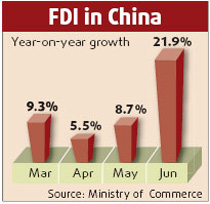The Producer Price Index (PPI) for China's industrial products rose by 3.2 percent in October from a year earlier, the National Bureau of Statistics (NBS) said on Monday.
The purchasing price of raw materials, fuel and power rose by 4.5 percent from a year earlier, the NBS said in its monthly report.
The PPI for means of production was up 3.1 percent and that of livelihood went up 3.5 percent, said the report.
The price index of food, a major driving force of the country's CPI, ballooned by 8.6 percent, compared with the growth rate of 1.3 percent for garments and 1.9 percent for daily commodities.
The country's consumer price index (CPI), a major barometer for inflation, eased slightly to 6.2 percent in September after surging to an 11-year monthly high of 6.5 percent in August.
Despite the slight drop in September, the CPI for the first nine months still climbed 0.2 percentage points from 3.9 percent for January to August.
Zhu Zhixin, deputy director of the National Development and Reform Commission (NDRC), said about 86 percent of the rise, or 3.5 percentage points, was generated by food price hikes. He predicted the prices for farm produce, which triggered a drastic rise in the CPI and sparked inflation concerns, would continue to maintain a high level.
According to the NBS report, the PPI of crude oil went up 4.2 percent in October from a year earlier. The PPI of diesel and kerosene rose by 1.5 percent and 0.3 percent, while that of gasoline went down by 5.0 percent.
The NDRC raised the price of gasoline, diesel oil and aviation fuel by 500 yuan per ton from November 1 this year, aiming to reduce the burden on China's oil producers created by the gap between the international and the domestic crude oil price, which is fixed by the government.
The People's Bank of China, the country's central bank, has recently stressed that to bring order to the prices of resources and energy is an inevitable requirement for the balanced growth of economy. But the reform of resources and energy prices may increase the pressure on price hikes of these products in a short run.
The NBS's monthly report also revealed that the PPI of large-sized rolled steel rose by 9.5 percent while that of medium-sized rolled steel rose by 16.5 percent and that of small-sized rolled steel rose by 18.8 percent.
Strong demand on the international market was pulling up the steel prices and the domestic demand for steel and cement was backed up by the increasing fixed assets investment, according to an NDRC report.
(Xinhua News Agency November 13, 2007)


